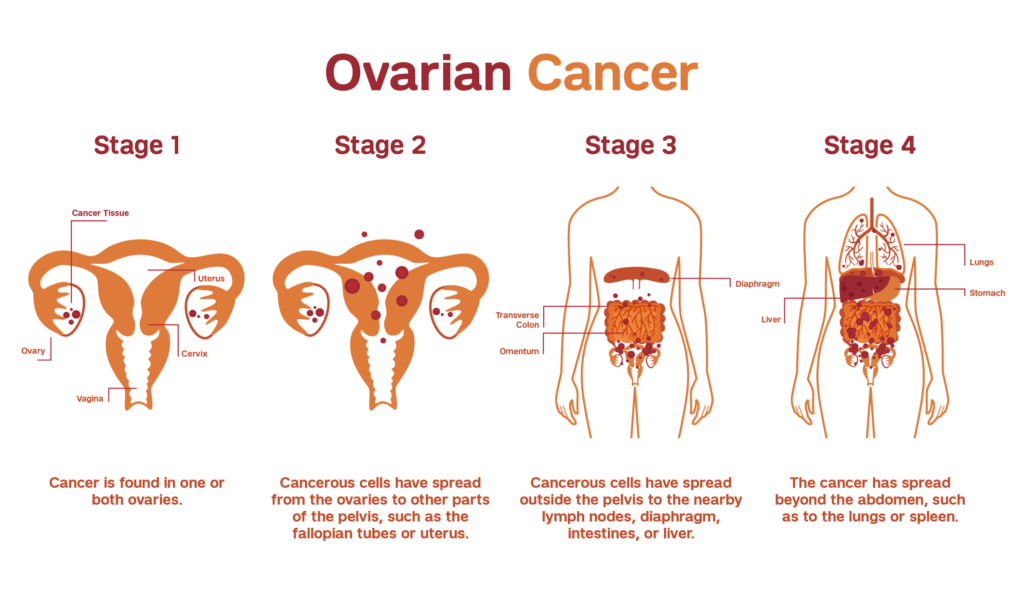Ovarian Cancer Stages
There are four stages of ovarian cancer, stages 1 through 4. Each is determined based on the spread of cancer in the body. After the diagnosis, staging is done. Staging is a process where the spread and the tumor’s length are detected. Read More
Top Doctors For Ovarian Cancer Stages Treatments
Top Hospitals For Ovarian Cancer Stages Treatments
Ovarian Cancer Stages
Table of contents
Ovarian cancer is the growth of unwanted abnormal cells in the ovary. These cells multiply uncontrollably, leading to the formation of tumors. If undetected and left untreated, cancer of the ovaries occurs. Some of the signs and symptoms include:
- eating with difficulty,
- frequent urge to urinate,
- abnormal pain,
- abnormal bloating,
- fatigue,
- back pain,
- weight loss,
- painful intercourse, etc.
The severity of the symptoms increases as the tumor spreads and grows.
What are the stages of ovarian cancer?
There are four stages of ovarian cancer, stages 1 through 4. Each is determined based on the spread of cancer in the body. After the diagnosis, staging is done. Staging is a process where the spread and the tumor’s length are detected. The location and size of the tumor are also detected. It is done by taking tissues to be examined from parts of the body, the pelvis and the abdomen.
Staging tells the doctor the cancer’s severity, which helps determine the best treatment form. The survival rate of a woman who has cancer is also determined by its severity.
The four stages of ovarian cancer differ by severity, stage 4 being the most severe and most advanced. How one woman experiences cancer is different from how another woman experiences it. However, the stages are similar and are treated in the same way. Surgery is done to determine the exact stage of ovarian cancer.
The generally accepted staging systems are the following:
- International Federation of Gynecology and Obstetrics (FIGO) system, and
- American Joint Committee on Cancer (AJCC) system.
These systems help classify staging using 3 factors.
- Extent of the Tumour (T) – This can also mean the size of the tumor. Answers to how far cancer has spread to the ovary and fallopian tube and whether cancer has reached the pelvic organs will be provided.
- Spread to the Nearby lymph Nodes (N) – Here, the cancer is checked to know if it has spread to the lymph nodes or around the aorta.
- Spread to Distant Sites (M) – Here, it is determined if cancer has surrounding fluids of the lungs or organs such as the liver or bones.
These factors, T, N and M, are categorized and determined based on the information in a process named stage grouping. This process aids in determining the stage a woman is in. There are surgical and clinical stages.
- The Surgical or Pathologic Stage – This is used by the staging systems, which are determined by tissues examined after an operation.
- The Clinical Stage – This depends on the findings from a biopsy, physical examinations and imaging tests before surgery.
The Four Stages
Stage I Ovarian Cancer
Also called early ovarian cancer, stage 1 is the earliest stage of cancer and has three substages – A, B, and C.
Stage IA – the cancerous cells are found within one ovary or fallopian tube.
The Stage IB – at this point, cancer has spread to both ovaries or fallopian tubes.
Stage IC – cancer has spread further outside the ovaries or fallopian tubes. It has gotten to the peritoneal cavity and its tissue lining. Also, the ovaries covering called the capsule due to surgery have been split open. This may lead to the further spread of cancer.

Treatment
Treatment option for stage 1 ovarian cancer varies, but surgery is the major treatment. Before a decision is made based on the best form of treatment, doctors have to consider several factors. These factors include:
- the substage of the early ovarian cancer (A, B or C),
- the grade of cancer,
- the cell-type cancer began in,
- the woman’s age,
- whether the woman wants any more children, and
- other medical conditions the woman might have.
If surgery is the chosen treatment option, the ovaries, fallopian tubes and the womb (including the cervix) will be removed surgically. The surgery is performed to know how far cancer has spread and to remove the cancerous cells from the body. When the woman wants to have children in the future, the womb and the unaffected ovary will not be removed.
Chemotherapy is recommended in cases where the individual has stage IC ovarian cancer or if the cancer is of a high grade. The aim is to reduce the chances of cancer coming back.
Stage II Ovarian Cancer
This stage follows stage 1, and it is divided into two substages – A and B.
Stage IIA – At this stage, the cancerous cells have spread from the ovaries or the fallopian tubes to the uterus.
Stage IIB – The cancerous cells have invaded the pelvic organs, which include the bladder, colon or rectum, from the peritoneal cavity.
Treatment
The treatment options for stage 2 ovarian cancer are majorly surgery and chemotherapy. Sometimes, the cancer may not entirely be removed, but the treatment done will help prolong the life of the individual by controlling the cancer. Factors considered before choosing a treatment option are:
- the spread of cancer in the body,
- if the cancerous cells can be removed completely, and
- the general well-being of the individual.
If chemotherapy is done after surgery, called adjuvant chemotherapy, the aim is to reduce the chances that cancer will come back. During surgery, the surgeon will remove as many cancerous cells from the body as possible. The chemotherapy after the surgery is done to reduce what is left of the cancerous cells. Another surgery may be done afterward. Surgery done by chemotherapy is called debulking surgery.
Chemotherapy can be done before and after surgery. It is called primary or neoadjuvant chemotherapy. After examining the scans that show cancer, the surgeon decides if all the cancerous cells can be removed, The surgeon also checks if the individual is healthy enough. These are checked to determine if chemotherapy will be done as the first treatment.
If the cancerous cells have shrunk reasonably halfway through the chemotherapy, surgery (interval debulking surgery (IDS)) will be conducted. After the surgery, the chemotherapy course continues.
Stage III Ovarian Cancer
This is a more advanced stage of cancer with three substages – A, B and C.
Stage IIIA – The spread of cancer can detect this stage to the retroperitoneal lymph nodes. By closely examining with microscope tissue samples from a patient, the pathologist will be able to tell whether cancer has spread outside the pelvis to the peritoneum and even to nearby lymph nodes.
Stage IIIB: At this point, a surgeon can see cancer in the peritoneum, which is now about 2 cm or smaller. The cancerous cells have spread outside the pelvis and the nearby lymph nodes.
Stage IIIC: Cancer has become larger to 2 cm or more. It spreads outside the pelvis to the peritoneum and outside the liver or the spleen. It has also spread to the lymph nodes.
Treatment
As in stage 2 ovarian cancer, stage 3 ovarian cancer can be treated majorly by surgery and chemotherapy, and the same factors are considered. The following treatment options can be done:
- chemotherapy after surgery, or
- chemotherapy before and after surgery.
Some cases of stage 3 cancer may involve the individual taking a type of targeted drug treatment called bevacizumab. This drug is taken together with chemotherapy.
Surgery may not be possible when the cancerous cells have spread too far in the body. In this case, chemotherapy can be done to reduce the cancerous cells and slow down their growth. Radiotherapy may be done depending on where the cancer is in the body. It is done to relieve the symptoms. Other treatment options to help relieve symptoms can also be conducted.
Stage IV Ovarian Cancer
This is the most advanced (metastatic) form of cancer with two substages – A and B.
Stage IVA – Around the extra fluid built up around the lungs now have cancerous cells. The fluid is called a malignant pleural effusion). Then,
Stage IVB – At this stage of cancer, the last stage has invaded the organs and tissues outside the abdomen and the groin’s lymph nodes. The lungs and the bones have been invaded.

Treatment
Treatment at this stage is done to control cancer in the body, for longevity and improve the well-being of the individual. Surgery and chemotherapy are the major treatment options. Other treatments are radiotherapy or targeted cancer drug treatment. The decides if surgery is necessary by checking:
- the extent of the cancer spread, and
- the general health of the individual.
The doctor may decide on any of the following:
- chemotherapy after surgery, or
- chemotherapy before and after surgery, or
- the chemotherapy without surgery.
If surgery is not an option, chemotherapy is done, and radiotherapy is to relieve the symptoms. In some cases, targeted cancer drugs with chemotherapy are applied.
“Medical Advice Disclaimer:
DISCLAIMER: THIS SITE DOES NOT PROVIDE MEDICAL ADVICE OR OPINION:
The information provided in this article or website by way of text, illustration, graphics, Images or any other form in this article or website is provided for informational purposes only. No information or material provided on this site is meant to be a substitute for a professional medical advice. Please refer to your family doctor or specialist in that field for any medical condition, diagnosis and treatment. Do not delay in contacting a professional on account of something you have read in this article or on this website.”
































































































